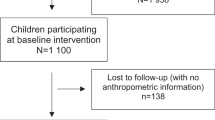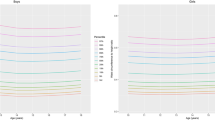Abstract
OBJECTIVE: Although the body mass index (BMI, mass index, kg/m2) is widely used as a surrogate measure of adiposity, it is moderately associated (r∼0.3) with height among children. We examined whether the resulting preferential classification of taller children as overweight is appropriate.
DESIGN: Cross-sectional analyses of children (ages, 3–17?y) examined the relation of height to adiposity (as assessed by BMI and skinfold thicknesses) and fasting levels of insulin. Longitudinal analyses examined the relation of childhood height and weight–height indices to adult (mean age, 25?y) levels of adiposity and fasting insulin.
SUBJECTS: Children (n=11?406) and adults (n=2911) who had participated in the Bogalusa Heart Study.
MEASUREMENTS: We constructed three weight–height indices: BMI, W/H3, and W/Hp. The triceps and subscapular skinfolds, as well as fasting levels of insulin, were also measured.
RESULTS: The classification of children as overweight (BMI-for-age ⩽95th percentile) varied markedly by height, with a 10-fold difference in the prevalence of overweight across quintiles of height between the ages of 3 and 10?y. Childhood height, however, was also related to skinfold thicknesses and insulin levels, and all associations were modified in a similar manner by age. Furthermore, childhood height was related to adult adiposity, and of the three childhood weight–height indices, BMI showed the strongest associations with adult adiposity.
CONCLUSIONS: Because BMI reflects the positive association between height and adiposity among children, it is a better weight–height index than is either W/H3 or W/Hp.
This is a preview of subscription content, access via your institution
Access options
Subscribe to this journal
Receive 12 print issues and online access
$259.00 per year
only $21.58 per issue
Buy this article
- Purchase on Springer Link
- Instant access to full article PDF
Prices may be subject to local taxes which are calculated during checkout


Similar content being viewed by others
References
Lohman TG . Applicability of body composition techniques and constants for children and youths. Exerc Sport Sci Rev 1986; 14: 325–357.
Marks GC, Habicht JP, Mueller WH . Reliability, dependability, and precision of anthropometric measurements. The Second National Health and Nutrition Examination Survey 1976–1980. Am J Epidemiol 1989; 130: 578–587.
Garn SM, Leonard WR, Hawthorne VM . Three limitations of the body mass index. Am J Clin Nutr 1986; 44: 996–997.
Prentice AM, Jebb SA . Beyond body mass index. Obes Rev 2001; 2: 141–147.
Daniels SR, Khoury PR, Morrison JA . The utility of body mass index as a measure of body fatness in children and adolescents: differences by race and gender. Pediatrics 1997; 99: 804–807.
Lindsay RS, Hanson RL, Roumain J, Ravussin E, Knowler WC, Tataranni PA . Body mass index as a measure of adiposity in children and adolescents: relationship to adiposity by dual energy X-ray absorptiometry and to cardiovascular risk factors. J Clin Endocrinol Metab 2001; 86: 4061–4067.
Rolland–Cachera MF, Sempe M, Guilloud–Bataille M, Patois E, Pequignot-Guggenbuhl F, Fautrad V . Adiposity indices in children. Am J Clin Nutr 1982; 36: 178–184.
Cole TJ . Weight–stature indices to measure underweight, overweight, and obesity. In: Himes JH (ed). Anthropometric assessment of nutritional status. Wiley-Liss: New York; 1991. pp. 83–111.
Freedman DS, Perry G . Body composition and health status among children and adolescents. Prev Med 2000; 31 (suppl): S34–S53.
Cole TJ, Rolland-Cachera MF . Measurement and Definition. In: Burniat W, Cole TJ, Lissau I, Poskitt EME (eds). Child and adolescent obesity: causes and consequences, prevention and management. Cambridge University Press; 2002. pp. 3–27.
Fung KP, Lee J, Lau SP, Chow OK, Wong TW, Davis DP . Properties and clinical implications of body mass indices. Arch Dis Child 1990; 65: 516–519.
Franklin MF . Comparison of weight and height relations in boys from 4 countries. Am J Clin Nutr 1999; 70: 157S–162S.
Hattori K, Hirohara T . Age change of power in weight/height(p) indices used as indicators of adiposity in Japanese. Am J Human Biol 2002; 14: 275–279.
Benn RT . Some mathematical properties of weight-for-height indices used as measures of adiposity. Br J Prev Soc Med 1971; 25: 42–50.
Garn SM, Clark DC, Guire KE . Levels of fatness and size attainment. Am J Phys Anthropol 1974; 40: 447–449.
Killeen J, Vanderburg D, Harlan WR . Application of weight–height ratios and body indices to juvenile populations––the National Health Examination Survey Data. J Chronic Dis 1978; 31: 529–537.
Himes JH, Roche AF . Subcutaneous fatness and stature: relationship from infancy to adulthood. Hum Biol 1986; 58: 737–750.
Lazarus R, Baur L, Webb K, Blyth F . Adiposity and body mass indices in children: Benn's index and other weight for height indices as measures of relative adiposity. Int J Obes Relat Metab Disord 1996; 20: 406–412.
Freedman DS, Kettel–Khan L, Serdula MS, Srinivasan SR, Berenson GS . Secular trends in height among children over two decades: The Bogalusa Heart Study. Arch Ped Adolescent Med 2000; 154: 155–161.
Diggle PJ, Liang KY, Zeger LS . Analysis of longitudinal data. Oxford University Press: New York; 1994.
Berenson GS ed: Cardiovascular risk factors in children. Oxford University Press: New York; 1980.
Kuczmarski RJ, Ogden CL, Grummer–Strawn LM, Flegal KM, Guo SS, Wei R, Mei Z, Curtin LR, Roche AF, Johnson CL . CDC growth charts: United States. Adv Data 2000; 314: 1–27; (http://www.cdc.gov/nccdphp/dnpa/growthcharts/sas.htm).
Ogden CL, Kuczmarski RJ, Flegal KM, Mei Z, Guo S, Wei R, Grummer–Strawn LM, Curtin LR, Roche AF, Johnson CL . Centers for Disease Control and Prevention 2000 growth charts for the United States: improvements to the 1977 National Center for Health Statistics version. Pediatrics 2002; 109: 45–60.
Kuczmarski RJ, Flegal KM . Criteria for definition of overweight in transition: background and recommendations for the United States. Am J Clin Nutr 2000; 72: 1074–1081.
Freedman DS, Dietz W, Srinivasan SR, Berenson GS . The relation of overweight to cardiovascular risk factors among children and adolescents: The Bogalusa Heart Study. Pediatrics 1999; 103: 1175–1182.
Cleveland WS . The elements of graphing data. Monterey, CA: Wadsworth Advanced Books and Software. 198. 170–178.
Meng XL, Rosenthal R, Rubin DB . Comparing correlated correlation coefficients. Psychol Bull 1992; 111: 172–174.
Michielutte R, Diseker RA, Corbett WT, Schey HM, Ureda JR . The relationship between weight–height indices and the triceps skinfold measure among children age 5 to 12. Am J Public Health 1984; 74: 604–606.
Frontini MG, Bao W, Elkasabany A, Srinivasan SR, Berenson G . Comparison of weight-for-height indices as a measure of adiposity and cardiovascular risk from childhood to young adulthood: the Bogalusa Heart Study. J Clin Epidemiol 2001; 54: 817–822.
Cole TJ . Weight/heightp compared to weight/height2 for assessing adiposity in childhood: influence of age and bone age on p during puberty. Ann Hum Biol 1986; 13: 433–451.
Billewicz WZ, Kemsley WFF, Thomson AM . Indices of adiposity. Br J Prev Soc Med 1962; 16: 183–188.
Billewicz WZ, Thomson AM, Fellowes HM . Weight-for-height in adolescence. Ann Hum Biol 1983; 10: 119–124.
Marshall WA, Tanner JM . Puberty. In: Falkner F, Tanner JM (eds). Human growth: a comprehensive treatise (2nd ed) Vol. 2 Postnatal Growth and Neurobiology. Blackwell Scientific Publications: Oxford; 1986. 171–203.
Mei Z, Grummer–Strawn LM, Pietrobelli A, Goulding A, Goran MI, Dietz WH . Validity of body mass index compared with other body-composition screening indexes for the assessment of body fatness in children and adolescents. Am J Clin Nutr 2002; 75: 978–985.
Author information
Authors and Affiliations
Corresponding author
Additional information
Supported by NIH Grants HL-38844 (National Heart, Blood and Lung Institute), HD-043820 (National Institute of Child Health and Human Development), AG-16592 (National Institute on Aging), by funds from the Centers for Disease Control and Prevention, and the Robert W Woodruff Foundation
Rights and permissions
About this article
Cite this article
Freedman, D., Khan, L., Serdula, M. et al. Inter-relationships among childhood BMI, childhood height, and adult obesity: the Bogalusa Heart Study. Int J Obes 28, 10–16 (2004). https://doi.org/10.1038/sj.ijo.0802544
Received:
Revised:
Accepted:
Published:
Issue Date:
DOI: https://doi.org/10.1038/sj.ijo.0802544
Keywords
This article is cited by
-
Understanding local ethnic inequalities in childhood BMI through cross-sectional analysis of routinely collected local data
BMC Public Health (2019)
-
Childhood obesity and adult cardiovascular disease risk factors: a systematic review with meta-analysis
BMC Public Health (2017)
-
Sugar-containing beverage intake in toddlers and body composition up to age 6 years: The Generation R Study
European Journal of Clinical Nutrition (2015)
-
Obesity in adolescence is associated with perinatal risk factors, parental BMI and sociodemographic characteristics
European Journal of Clinical Nutrition (2013)
-
Early life growth trajectories and future risk for overweight
Nutrition & Diabetes (2013)



